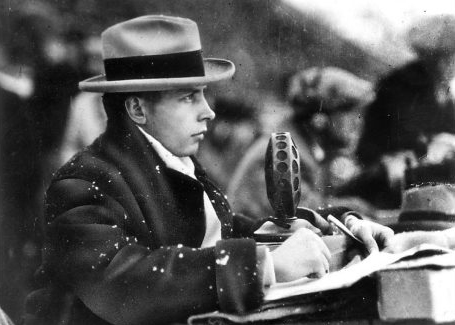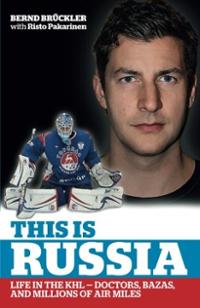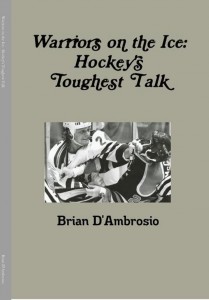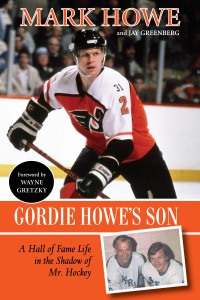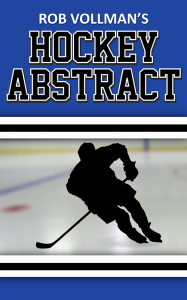* By clicking on a link to Amazon you will be supporting our site. Your cost will not change but we will receive a small and much appreciated commission.
We review many of the latest hockey books, adding them here as they are done. Please bookmark this page and come back from time to time. Publishers can write to Bruce to have their hockey books reviewed – editor@thehockeywriters.com
- A Review of Habs 365: Daily Stories from the Ice by Mike Commito
- Scotty Bowman: A Coach’s Life
- The Blake Geoffrion Story: A Book Review of Legacy on Ice
- Ken Dryden’s “The Game,” Still a Classic
- Reviewing The Awesome Game by Dave Hill
The Voices of Hockey: Broadcasters Reflect on the Fastest Game on Earth
With over 300 pages of stories, McKnight breaks the book up into 30 chapters – one for each of the existing NHL teams when the book was published. He includes 53 interviews and over 30 broadcasters – each sharing some of their greatest moments with the author and readers of this book.
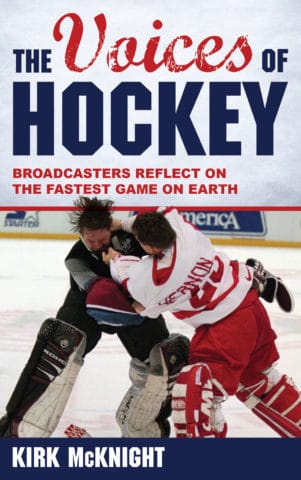
While it’s not his first time writing about broadcasters – having also written The Voices of Baseball: The Game’s Greatest Broadcasters Reflect on America’s Pastime – McKnight shares his passion for both the game and the voices behind it. But it wasn’t just about the author’s passion – rather a sort of respect for those who could keep up with such a quick game as well.
“When I was writing The Voices of Hockey, I found myself listening more to the hockey broadcasters, thinking to myself, ‘How do these guys do it?’” he wrote to me via email when I asked why he covered the broadcasters from the game. “I always said – tongue in cheek – their lungs are better reserved for the lead role in a Gilbert & Sullivan production. Hockey is non stop. There aren’t visits to the pitcher’s mound, seventh inning stretches, or two-minute warnings.”
But McKnight also wanted to pay homage to those who’ve been doing it for such a long time.
“These hockey broadcasters have been doing this just as long – if not longer – than most of the baseball broadcasters with whom I spoke. People like Bob Cole, Doc Emrick, and Jiggs McDonald are STILL doing it. Who can contest the intensity and excitement which is a game called by Emrick?”
And what’s better than a story about the tales behind the game? The people behind the curtains – the wizards to hockey’s Oz? So that’s exactly what McKnight did. He interviewed and gathered their stories and put it all together.
or to view directly on Amazon click this link: The Voices of Hockey: Broadcasters Reflect on the Fastest Game on Earth
*****
This is Russia: Life in the KHL – Doctors, bazas and millions of air miles by Bernd Bruckler with Risto Pakarinen (December 6, 2013, CreateSpace Independent Publishing Platform. Paperback. ISBN 9781494379285)
Austrian goaltender Bernd Bruckler did not grow up in a hockey thriving country. While his friends were out playing popular sports such as skiing and soccer, Bruckler wanted to stray from the rest and try something new — hockey. His parents made him dedicate his time to the game, which ended up paving his way to the professional level. As a young boy emerging as a teen, Bruckler had to skip all the fun activities such as partying because his focus was on success.
In the first few chapters, the book covers the difficulties Bruckler and European hockey players have in trying to play in better junior leagues in North America due to import restrictions. The Graz, Austria native had to try out for several teams before landing in the United States Hockey League with the Tri-City Storm. After one season in the USHL, Bruckler received offers from several big-name hockey universities, but committed to the University of Wisconsin on his first college visit.
While the book does detail much more of his early hockey career in detail, although interesting, the meat of the book lies during his time in the Kontinental Hockey League (KHL) with Torpedo Nizhny Novgorod and Sibir Novosibirsk.
Breakaway: The Inside Story of the Pittsburgh Penguins’ Rebirth by Andrew Conte (2011, Indianapolis: Blue River Press. Hardcover. ISBN 9781935628101)
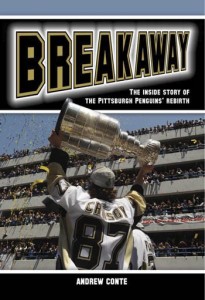
Once upon a time, the Pittsburgh Penguins’ former home, the Mellon Arena had been one of the most architecturally stunning buildings of its time. It was first named the Civic Arena when it opened in the 1960s and was built with a stainless steel dome roof that could open in warm weather. The building hosted orchestra performances, concerts and, of course, Pittsburgh Penguins hockey.
But over time, the building was no longer suitable for major events. Artists would skip Pittsburgh on concert tours, and hockey fans began to feel inconvenienced by crammed concourses, worn-out seating and lack of personal space. It was clear Pittsburgh needed a new arena.
Breakaway: The Inside Story of the Pittsburgh Penguins’ Rebirth covers the Penguins’ quest to get the new building. Author Andrew Conte, a reporter with the Pittsburgh Tribune-Review, presents the stories of the people involved in the arena quest and also details how the Penguins were performing on the ice to show how interest of the team went up and down, particularly in the early 2000s and after Sidney Crosby was drafted in 2005.
Warriors on the Ice: Hockey’s Toughest Talk
by Brian D’Ambrosio (2013: Jabberwocky Press. Kindle Edition. Pp. 229. $8.70.)
As human beings, we’re taught that every story has two sides – that people see things differently. In hockey, the ‘story’ that has surfaced and remained at the forefront for the sports’ discussions is the issue of fighting. Should it be allowed in the National Hockey League?
The league continues to institute rules in the hopes of reducing what some argue is an unnecessary part of the game – the instigator rule, the late-in-the-game coaches fine, and most recently the rule that penalizes players for removing their helmets.
We all hear the arguments from both sides – that fighting is a way of players self-policing their game, while others point out the long-term affects of a bare-knuckle brouhaha. But every once and a while, we witness incidents that force us to hold our breath and question fighting’s place in hockey all over again.
Brian D’Ambrosio’s book, Warriors on the Ice: Hockey’s Toughest Talk focuses on this long-debated subject. He uses interviews with some of the game’s all-time greatest tough guys to open up the conversation of how the role has changed over time – including references to recent incidents.
Gordie Howe’s Son
Gordie Howe’s Son: A Hall of Fame Life in the Shadow of Mr. Hockey, by Mark Howe with Jay Greenberg (2013, Chicago: Triumph Books. Hardcover. Pp. 336. $25.95. ISBN 978-160078-847-5)
[NB: Throughout the review I refer to the author and his father by their first names. This is for the sake of clarity and is not meant to imply familiarity with the family.]
In the 1998 edition of Total Hockey, writer Glen R. Goodhand notes that “family trees have been just as integral to Canada’s national game as ice and skates.” He cites around eighty examples of fathers and sons who have played in the NHL, although only one among them, Gordie, Mark and Marty Howe, actually played together at the same time.
After reading Mark Howe’s memoir Gordie Howe’s Son, it’s clearly no coincidence that at the age of 45, Gordie would skate alongside sons Marty (19) and Mark (18), and do so with great success for several years. Rather, it testifies not only to the hearty athletic genes of the Howe family, but also to their work ethic, their toughness, and further, to the extraordinarily strong Howe family bond.
Mark Howe, the Player
“Mark Howe was arguably the best defenseman in Flyers history [and] the best defenseman never to win the Norris Trophy.” David Sherman, Philadelphia Flyers Encyclopedia
Mark Howe played 22 seasons of professional hockey in a career stretching from 1973 to 1995. A six-time All-Star (in two leagues), before that he won a silver medal in the Olympics and the Memorial Cup in his only season in Major Junior. In his 16 stand-out seasons in the NHL, Mark scored 19 or more goals in six seasons and in 1985-86, he led the NHL in plus/minus with +86, finishing his NHL career a +400, good for 12th all-time.
Hockey Abstract
New to the Hockey Media scene this year is Rob Vollman’s Hockey Abstract
Vollman has been a fixture in the advanced hockey stat realm for many years (also at Hockey Prospectus), but this is his first annual guide that lays it all out there for fans of the game.
The result was an impressive piece of work. [For an in-depth review of the book, check out THW’s review by Ross Bonander.]
The most interesting Penguins-focused piece in the book related to the Luck factor.
Vollman calculated that Pittsburgh was the second luckiest team last year (behind only Toronto) and actually the third luckiest team since 2007. Certainly, the 48-game shortened schedule was a factor and opened the door for some crazy results.
Firewagon Hockey Review
Firewagon Hockey: The Game in the Eighties
By Mike Leonetti. (2004, Toronto: Firefly Books. Paperback. Pp. 224. $24.95. ISBN 978-1-5529-7911-2)
The term ‘fire-wagon hockey’ was coined in the 1950s, but it has come to signify the high-flying NHL of the 1980s. At no time was NHL offense more evident than during the highest-scoring decade in history. Mike Leonetti’s Firewagon Hockey: The Game in the Eighties is an excellent review of an era unmatched in terms of scoring at hockey’s highest level.
This is the era of 400-goal Edmonton squads, when 40-goal scorers were commonplace, and 50 in a season not uncommon. In fact, a low-water-mark, 1986-87, still saw 5 players score 50 or more. By contrast, the league saw 5 players score 50 in a season only once since 1996-97.
It seems unlikely we’ll ever see the kind of freewheeling, twine-bulging play that existed in those days, but they live again in the pages of Firewagon Hockey.
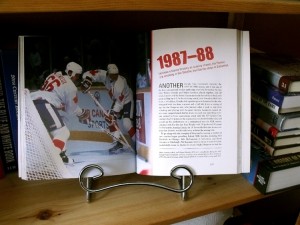
Presented in a year-by-year format, Mike Leonetti guides us through the exploits of some of the best-known, and maybe no longer so well-known players who starred during the 1980s, and some of the teams we may have forgotten along the way.
read the full review by Mark Ascione…
